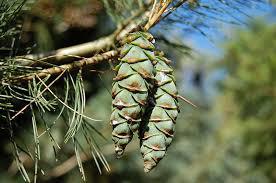Pinus × hunnewellii, as described in 1952 by Albert G. Johnson, in Journal of the Arnold Arboretum, vol.33, is commonly known as Hunnewell's white pine, named for Hunnewell Arboretum in Wellesley, Massachusetts where it was originally found in 1949.
Description. Hunnewell's white pine is a spontaneous garden hybrid that has been recreated deliberately. The parent species' are two naturally geographically, widely separated, typical white pines in subsection Strobus, namely Japanese white pine (Pinus parviflora) and Eastern white pine (Pinus strobus). It is similar to both parents in their shared characteristics and intermediate or generally favoring one or the other in the features in which they differ. The original trees found has P. strobus as the seed parent. The reciprocal hybrid has proven to be rather difficult to recreate, probably due to the difference is seed sizes.
It is faster growing than both parents, displaying strong "hybrid vigor," and has a loose, open crown whose irregularity is accentuated by susceptibility to white pine weevil, which kills the lead shoots. This hybrid vigor also presents itself in forking of terminal shoots and even seed cones. Further, lateral branches often turn upward resulting in the creation of new lead shoots.
